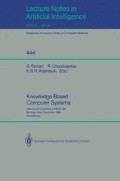Abstract
An approach for dealing with novel terms in input to a natural language interface to databases is presented. Traditionally terms not found in the lexicon are assumed to be database values. It is thus taken for granted that customization is complete, i.e., the lexicon contains all synonyms for all attributes. The problem then becomes one of determining the attribute of which the novel term is a value. The present approach entertains the possibility that the novel term is either a database value or a structural term. We argue that there are linguistic phenomena which in conjunction with the usual methods of defining database values can be used to distinguish between values and structural terms. Novel terms are treated as ambiguous, and the interface attempts to constrain the set of candidate interpretations using certain heuristics. If these methods fail to disambiguate the term, a focussed, informative response is generated for the set of interpretations. When appropriate, the user is solicited for information which the interface uses to create a lexical entry for the previously novel term.
Preview
Unable to display preview. Download preview PDF.
References
Carbonell, J. G. and Hayes, P. J. “Robust parsing using multiple construction-specific strategies.” Natural Language Parsing Systems. Ed. L. Bolc. Berlin: Springer, 1987.
Damerau, F. “Prospects for knowledge-based customization of natural language query systems.” Vol. 24: pp. 651–664, 1988.
Hall, G. Querying Cyclic Databases in Natural Language. Simon Fraser University CMPT TR 87-4, 1987.
Hall, G., Luk, W. S., Cercone, N. and McFetridge, P. “A solution to the MAPP problem in natural language interface construction.” Proceedings of International Computer Science Conference '88, Hong Kong. Pp. 351–359, 1988.
Harris, L. R. “The ROBOT system: natural language processing applied to database query.” Proceedings of Annual Conference of the ACM, Washington, D.C. Pp. 165–172, 1978.
Harris, L. R. “Prospects for practical natural language systems.” Proceedings of 18th ACL, Philadelphia, Pa. 1980.
Hendrix, G., Sacerdoti, D., Sagalowicz, D. and Slocum, J. “Developing a natural language interface to complex data.” ACM Transactions of Database Systems. Vol. 3: pp. 1978.
Johnson, D. E. Design of a robust, portable natural language interface grammar. IBM Thomas Watson Research Center RC 10867, 1984.
Kao, M., Cercone, N. and Luk, W. S. “Providing quality responses with natural language interfaces: the null value problem.” IEEE Transactions on Software Engineering. Vol. 14: pp. 959–984, 1988.
Kaplan, S. J. “Cooperative responses from a portable natural language database query system.” Computational Models of Discourse. Ed. M. Brady and R. C. Berwick. Cambridge, Ma.: MIT Press, 1983.
Kaplan, S. J. “Designing a portable natural language database query system.” ACM Transactions on Database Systems. Vol. 9: pp. 1–19, 1984.
McFetridge, P., Hall, G., Cercone, N. and Luk, W.-S. “Knowledge Acquisition in SystemX: A Natural Language Interface to Relational Databases.” Proceedings of International Computer Science Conference '88, Hong Kong. Pp. 604–610, 1988a.
McFetridge, P., Hall, G., Cercone, N. and Luk, W.-S. “System X: A Portable Natural Language Interface.” Proceedings of 7th Biennial Conference of the CSCSI, Edmonton, Alberta. Pp. 30–38, 1988b.
Moser, M. G. “Domain dependent semantic acquisition.” Proceedings of First Conference on Artificial Intelligence Applications, Denver, Co. Pp. 13–18, 1984.
Shwartz, S. P. “Problems with domain-independent natural languages datbase access systems.” Proceedings of ACL 20th Annual Meeting, Pp. 60–62, 1982.
Thompson, C. W. “Recognizing values in queries or commands in a natural language interface to databases.” Proceedings of First Conference on Artificial Intelligence, Denver, Co. Pp. 25–30, 1984.
Wiederhold, G. Database Design. New York: McGraw-Hill Book Company, 1983.
Woods, W. A., Kaplan, R. M. and Nash-Webber, B. The Lunar Sciences Information System: Final Report. Bbn Rep. 2378. Cambridge, Mass.: Bolt, Beranek and Newman, 1972.
Author information
Authors and Affiliations
Editor information
Rights and permissions
Copyright information
© 1990 Springer-Verlag Berlin Heidelberg
About this paper
Cite this paper
McFetridge, P., Groeneboer, C. (1990). Novel terms and cooperation in a natural language interface. In: Ramani, S., Chandrasekar, R., Anjaneyulu, K.S.R. (eds) Knowledge Based Computer Systems. KBCS 1989. Lecture Notes in Computer Science, vol 444. Springer, Berlin, Heidelberg. https://doi.org/10.1007/BFb0018391
Download citation
DOI: https://doi.org/10.1007/BFb0018391
Published:
Publisher Name: Springer, Berlin, Heidelberg
Print ISBN: 978-3-540-52850-0
Online ISBN: 978-3-540-47168-4
eBook Packages: Springer Book Archive

